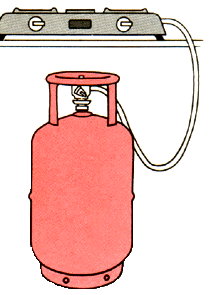|
What are the parts of your gas
installation? |
|
|
 |
|
|
|
|
» |
A cylinder with a
self-closing valve. |
|
» |
A pressure
regulator, which is connected to the outlet of the valve. |
|
» |
A gas stove or a
cooking range (appliance). |
|
» |
Rubber tube
connecting the regulator to the appliance. |
|
|
|
|
|
How should
the cylinder be placed? |
|
|
 |
|
» |
Vertical with
valve facing upwards. |
|
» |
Away from any
source of heat or a naked flame. |
|
» |
On or above ground
level with adequate ventilation. |
|
» |
In an easily
accessible position. |
|
|
|
|
|
How do you
install your gas connection? |
|
|
 |
|
» |
Make sure the valve on the
cylinder is shut, by turning the pressure regulator knob to
the OFF position.
|
|
» |
Open the valve by turning the
pressure regulator knob to the ON (vertical) position.
|
|
» |
Make sure the burner taps are
also closed.
|
|
» |
Make sure there is no smell of
gas.
|
|
» |
Light a match and hold it to
the burner.
|
|
» |
Turn on the burner by rotating
the knob in the ,anti-clockwise direction. ]
|
|
» |
Shut the burner after use.
|
|
» |
Shut the valve of the cylinder
by turning the pressure regulator knob to
the OFF position.
|
|
|
|
|
|
ALWAYS REMEMBER TO SHUT THE
VALVE WHEN STOVE IS NOT IN USE ESPECIALLY AT NIGHT.
|
|
|
|
|
|
How to take care
of your stove? |
|
|
 |
|
» |
Harsh cleaners can damage the
finish. Don't use abrasive powders, highly acidic or
alkaline cleansers.
|
|
» |
Wait for surfaces to cool. If
the stove is hot and you try to clean it with a wet cloth,
the surface finish may crack.
|
|
» |
Some foodstuffs can damage the
finish. Vinegar, sour milk, citrus fruits juices, tamarind
decoctions
|
|
» |
can all damage the finish. If
some such liquid spills on the stove, wipe it off with a dry
cloth, wait for the stove to cool, clean with warm soap
water and dry.
|
|
» |
Ordinary stains can be cleaned
easily. Some baking soda on a damp cloth does the trick. A
mild cleanser may be used for stubborn stains.
|
|
» |
A chrome finish can be cleaned
with a damp cloth. Or any good chrome cleanser.
|
|
» |
Clean the burner head and
mixing tube the right way. Immerse the mixing tube assembly
and the burner head completely in a boiling solution of
washing soda. Keep it for 20 minutes. Rinse thoroughly
internally and externally. Dry completely to prevent
corrosion.
|
|
» |
The burner holes should be
cleaned with a soft wire. The mixing tube can be cleaned
with a stiff bottlebrush.
|
|
» |
Pan supports can be cleaned the
same way.
|
|
|
|
|
|
What are
things to do when your cylinder is being changed? |
|
» |
Put out all fires in the
kitchen. This includes diyas, agarbatties, cigarettes and
all naked flames; otherwise any leakage of gas could result
in fire.
|
|
» |
Switch off all electrical
appliances.
|
|
» |
Shut the taps on the stove.
|
|
» |
Have the rubber tube and all
the connections checked for leakage with soap solution.
|
|
» |
Insist that your deliveryman
checks cylinder valve and O-ring for any leakage.
|
|
|
|
|
|
Where should
the stove be placed? |
|
|
 |
|
» |
At a higher level than the
cylinder - about 2 ft to prevent the tube from catching
fire.
|
|
» |
Against a wall to make sure
that clothes don't catch fire.
|
|
» |
Away from curtains.
|
|
» |
Away from wind draughts to
prevent the flame going out and causing leakage of gas.
|
|
|
NOTE: Make
sure there are no shelves above the stove
REMEMBER THAT YOUR APPLIANCE MUST HAVE AN ISI MARK AND HAVE
IT TESTED BY A MECHANIC BEFORE YOU USE IT.
|







